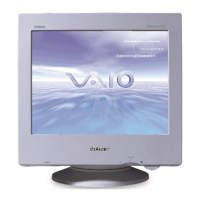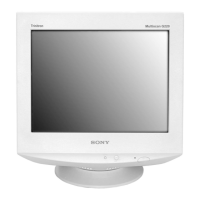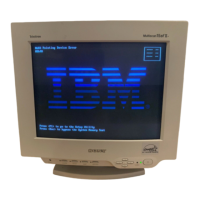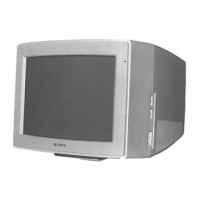
Do you have a question about the Sony Trinitron CPD-E500 and is the answer not in the manual?
Details on CRT pitch, deflection, and viewable image size.
Maximum and recommended resolution, and standard image area dimensions.
Horizontal and vertical deflection frequency ranges.
AC input, power consumption, dimensions, mass, Plug and Play, accessories.
Test for AC leakage from exposed metal parts to earth ground.
Details monitor power consumption modes and indicators.
How self-diagnosis uses power indicator status and troubleshooting actions.
Horizontal and vertical timing parameters for production mode 1.
Warnings related to power, static discharge, installation, and maintenance.
Identifies front and rear parts of the monitor with cross-references.
Instructions for connecting monitor to computer via video and power cables.
Power on sequence and steps for resolving 'no picture' issues.
How to change the on-screen menu language.
How to access and navigate the main menu using the control button.
Overview of available menu adjustments like SIZE, GEOM, COLOR, etc.
How to adjust brightness and contrast settings.
How to adjust picture size, centering, and zoom functionality.
How to adjust picture rotation, shape, and color convergence for clarity.
How to adjust landing and moire cancellation for optimal picture quality.
Adjusting color temperature using EASY, EXPERT, or sRGB modes.
Degaussing, menu position, and control lock settings.
Procedures for resetting single or all adjustment data.
Explains preset/user modes and power saving function details.
Explains damper wires, on-screen messages, and troubleshooting steps.
Steps for resolving 'no picture' issues based on indicator status.
Specific setup and troubleshooting for Windows and Macintosh systems.
Remedies for picture flickering, fuzziness, ghosting, color issues, and shadows.
Troubleshooting for unresponsive buttons and startup hum.
How to display model, serial number, and manufacture date.
Actions to take based on power indicator status (green, flashing orange).
Summary of CRT, resolution, electrical, and physical specifications.
Step-by-step instructions for removing the monitor cabinet.
Instructions for removing the D board.
How to remove the A board and I/O terminal board assembly for CPD-E500E.
How to remove the A board and terminal bracket for CPD-E500.
Diagram showing harness routing for the CPD-E500E model.
Checks for HV and beam current circuits to prevent X-ray emissions.
Procedures to check HV regulator and protector circuit operations.
Procedures to check beam current protector circuits on different boards.
Steps for adjusting screen landing using specific coils and signals.
Final adjustments for DY, landing, and color purity after service.
Procedures for rough convergence, focus, and convergence specifications.
Specifications for white balance and picture position/size.
Overall block diagram of the monitor's functional units.
Schematic diagram showing the overall frame connections.
Identifies the physical location of circuit boards within the monitor.
Schematic and PWB diagrams for various boards (A, H1, J, D, N, G).
List of semiconductor components used in the monitor.
Exploded view of the monitor chassis and main components with part numbers.
Exploded view of the picture tube assembly and related parts.
List and diagram of packing materials for shipping or storage.
List of capacitors with part numbers, descriptions, and specifications.
List of resistors with part numbers and specifications.












